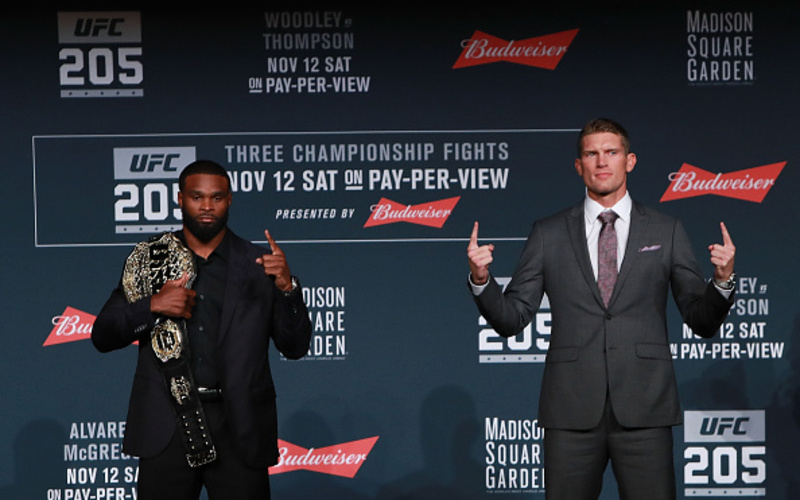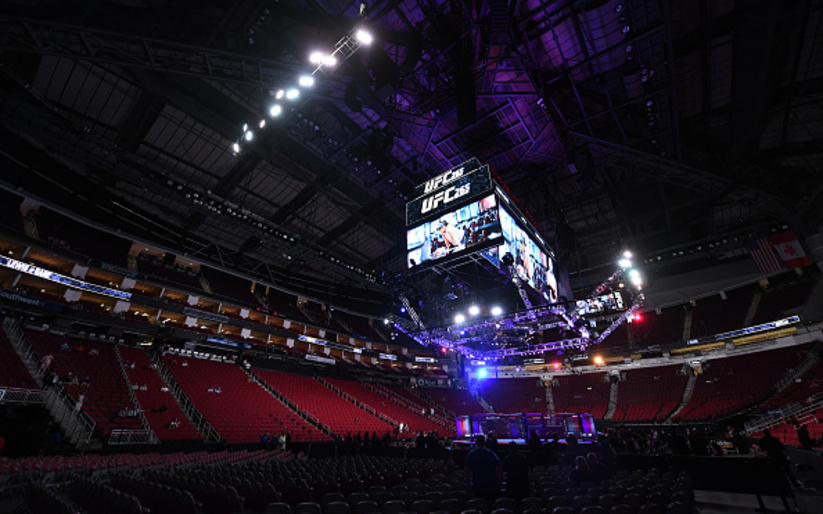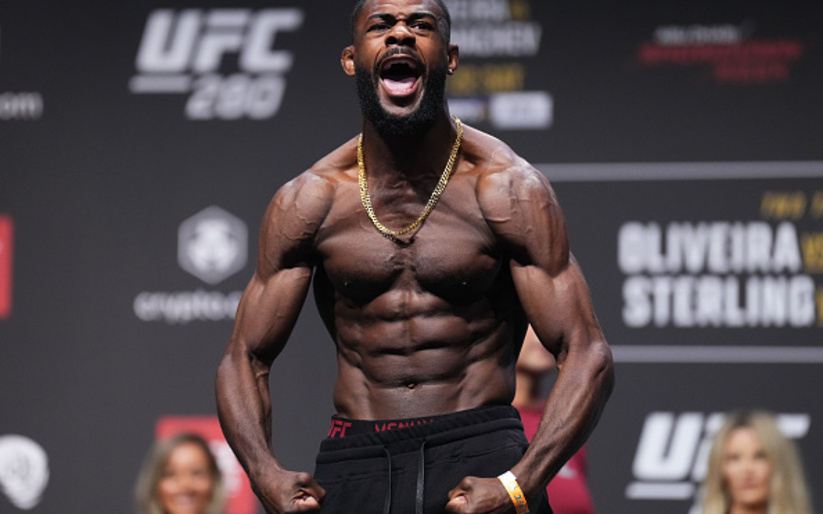When Tyron “The Chosen One” Woodley and Stephen “Wonderboy” Thompson face off on November 12 at UFC 205, it will be more than simply a clash of fighters. It is a clash of styles.
Their ideas and abilities are so at odds with each other that neither man could ever hope to succeed using the other mans style. Woodley is the epitome of explosive power. “Wonderboy” represents the use of length and distance. Neither is wrong in their approach. In fact you could argue that both men have found the style that suits their frames and mentalities perfectly. They are the archetypes of their styles, the names that spring to mind when someone says “wrestler with a big punch” or “movement based karate fighter”.
This fight is about who will be able to implement their style better. At the end of the day, it comes down to more than just the fighters. The winner of this fight could go on to define the type of style that is perceived to be required to be successful in MMA today. Will it be explosive power, or poise and footwork?
A Guide To UFC 205: Woodley vs. Thompson
Tyron Woodley: Genetically Gifted, Technically
Woodley’s nickname is ironically apt. Existential discussions about the concept of pre-determined lives aside, along with remarks about how choosing to be named “The Chosen One” seems to be flying in the face of the idea of being chosen, it is undeniable that Woodley was genetically chosen to fight the way he does. Walking around at around 200 pounds of dense muscle packed on to a 5′ 9″ frame, it is no surprise where Woodley’s explosiveness comes from. A decorated collegiate wrestler, his ability to close the distance is key to implementing his gameplan.
For such a decorated wrestler, Woodley rarely initiates takedowns. He averages 1.89 takedowns per 15 minutes of fighting. Since coming to the UFC, Woodley has scored exactly 3 takedowns, all against Carlos Condit. So if he isn’t taking people down, what is he doing? So glad you asked.
A One Trick Pony
On the feet, Woodley is all about his right hand. Just like Johny Hendricks and Josh Koscheck before him, Woodley has learned that his years on the wrestling mat has developed power that can be transferred directly to his opponents face via his fist. He has also fallen into the trap of relying on that power to the exclusion of building a varied arsenal.
That is not to say that he is not technically proficient at using his right. Woodley has a pretty developed right hand game, at least as far as an overhand right can be developed. His go to move is to move around, wait, and bait his opponent into coming after him. When they do, he will look to parry the jab and fire the right hand over the top.
If his opponent refuses to come to him, Woodley is allowed to explode forward. He will show a jab to draw a reaction and then it is the same right hand over the top.
The After Thoughts
What is infuriating about watching Woodley fight is seeing how effective he is with everything else he uses. His takedowns are great, and his ground and pound can be ferocious.
Far and above the most underutilized section of Woodley’s game are his leg kicks. Woodley’s leg kicks have a dramatic effect on his opponents nearly every time he uses them. On multiple occasions, Woodley has lifted opponents off their feet with his kicks.
The Potential For Greatness
Between his wrestling and his kicking, Woodley has the tools to be a rounded fighter. His jab is even serviceable when he commits to using it as a punch and not a feint. Yet again and again he will insist on relying on his right hand, with the rest of his game as an afterthought. Including his other talents would go a long way to making Woodley’s right hand even more dangerous.
Faking takedowns into right hands has been the age-old set up for wrestlers, but it relies on the threat of the takedown actually being present. Frankie Edgar is a fantastic example of someone who will level change into punches, then land takedowns when the opponent starts expecting the right hand. Fabricio Werdum famously bested Mark Hunt by shooting a takedown, then faking a takedown into a flying knee, knocking the much better striker out cold by using the expectation of the takedown to his advantage.
Fedor Emelianenko knocked out Pedro Rizzo by throwing a few leg kicks, then faking a leg kick into a right hand. You can see Rizzo go to check the kick he thinks is coming, only to eat a right hand while standing on one leg.
These are examples of how diversifying your game can actually help you indirectly. You cannot defend against everything at the same time. The more you have to worry about, the higher the chance you make a mistake. With the power he posseses, nobody is suggesting Woodley abandons his right hand. What he should be doing is looking to create opportunities to land his right hand using his other skills. Instead he tries to force the right hand into every situation, with mixed results.
The Curse Of Being Predictable
Woodley’s biggest problem has always come against people who are aware of his right hand. Notoriously shoddy striker Jake Shields did a great job of staying behind his lead shoulder and avoiding the right hand. Extending the lead hand to force Woodley to punch around it shortened the punches range and Woodley never changed his focus from the right hand, and as a result lost the decision.
Rory MacDonald stayed long and pressured Woodley to the fence. Woodley’s ring awareness has always been a little shaky. He routinely walks himself to the fence, and that is where he gets himself in trouble. Using his own jab to draw Woodley’s hands out of position, MacDonald would rattle combinations off while always staying aware that the right hand could be coming back.
When his opponents look out for the right hand, Woodley’s charges become less dangerous. Even Condit, whom Woodley battered with right hands in the early going, had success in coming in and retreating as soon as Woodley began to throw his right.
Stephen Thompson: The Advantages Of Being Unusual
There are a lot of fighters who fight like Woodley. He may be the best at doing it, but great wrestlers with big punches are hardly thin on the ground in MMA. You would be hard pressed to find another man who moves and fights like Stephen Thompson.
Keeping his stance wide and his hands by his waist, Thompson stands almost side-on when facing his opponents. This is a common stance in tae-kwon-do, where leg kicks are not allowed. It provides the smallest target to his opponent while placing his lead hand and foot closer to them.
The small bouncing movement made by Thompson highlight the key to his success: distance management.
Keeping Boundaries
Much like former light heavyweight champion Lyoto Machida, Thompson’s footwork focuses on maintaining a specific distance between himself and his opponent. This is the distance that is to far to be hit from, but too close to be comfortable. He will hover just on the edge of his kicking range and for every step his opponent takes, Thompson, matches it.
It is by religiously maintaining this distance that Thompson controls the pace of his fights. As such he forces his opponents to try and close the gap. The longer he refuses to engage, the more frustrated they become. If they refuse to close the distance, Thompson controls the fight using his lead leg. This alone marks him as something unique, as very very few fighters utilize this style in MMA. It is centered around the staple of point fighting competitions: the sidekick.
The Kickers Jab
Thompson’s game is based around his ability to operate from a greater distance than his opponent. By using his lead leg side kick, he can jam the advance of his opponent and cover a lot of distance quickly while using a technique that keeps him relatively safe.
The side kick is often referred to as the jab for kickers. I think this is a fair statement. As opposed to a teep or snap kick, the sidekick turns over the hips to extend your range, just like you turn your shoulders when you jab. It is simple geometry. It is the longest weapon going from the closest start point and traveling the shortest route to its target. If allowed this range, Thompson can strike at will with little fear of repercussion.
While the side kick is a nice point scorer, it is far from the meat and potatoes of Thompson’s style. It is more like the bread-sticks at a restaurant. You are guaranteed to see it in all of his fights, but by itself it does not make a meal. The risk of a sidekick is that if the timing is slightly wrong, you give up your back to your opponent very easily.
As a result Thompson will sidekick less frequently than you would think. Enough to get his opponent thinking about it, but not enough to risk them catching on to it. Where he really does his damage is, surprisingly enough, with his hands.
Baiting The Trap
By religiously forcing distance upon his opponent, Thompson makes them want to close the gap. The longer he refuses to engage and continues to move away, the more frustrated they become. Thompson has fantastic positional awareness. He is constantly aware of how close he is to the cage and as a result he rarely gets stuck on it. The longer he plays this game, the less concerned opponents become with him actually firing back. Once he has his opponent chasing,Thompson will plant his feet and meet his opponent with punches.
It would not be right to say Thompson is fundamentally a good boxer. What he is however is an effective puncher. He has a good understanding of placing shots and his punches definitely carry some power. However he does keep his head straight up and his hands down even when punching. When he is punching back is when he is most vulnerable.
It’s a dangerous game that Thompson plays with his hands low, but it has its advantages. One of the surprising benefits of having your hands low is that people tend to try and punch you in the face. It may not sound like a plus, but when someone stands as side on as Thompson, it can be very difficult to check leg kicks. By offering his opponents a free shot at his face, he keeps the attention away from his lead leg and body.
Thompson has shown a great ability to hit people and avoid the return, especially the right hand.
It’s this, rather than his famous kicks, that is the foundation of Thompson’s striking. After eating a few shots, many opponents find themselves sitting on the edge of Thompson’s range, suddenly reluctant to lead. This is when some of Thompson’s more impressive techniques come out.
Add the Sizzle On The Steak
The most recognizable trait of Thompson’s lead leg game is his use of the trifecta of the sidekick, hook kick, and round kick. All chamber in a similar fashion but all target different areas. Thompson builds off the expectation of the sidekick to set up the other two kicks.
You will notice that Thompson does not chamber his round kick like most fighters. Rather than loading the hips and swinging from the side, he will lift the leg identical to a sidekick and kick straight in front of him. This means that the kick loses its arcing nature but it now comes from an unusual angle, which catches many opponents by surprise.
None of these techniques would be effective if Thompson did not use his boxing to first convince his opponents to stay on the edge of his range. His ability to maintain his range without getting stuck on the fence and his ability to catch guys coming after him is what keeps him in the position to throw his kicks. Without his distance management and boxing, Thompson’s kicking game falls apart.
Final Thoughts
Both guys are playing with fire. Woodley likes to hang around on the outside and explode on guys. Thompson likes to keep people on the outside and let people charge towards him. The fight has both men playing to their opponents’ strengths.
From Thompson, the key is to stay aware of the right hand. Because he carries so much muscle, Woodley has a tendency to fade in the second and third round, never mind the fourth and fifth. Because he operates at a greater distance than most, he should have more warning of Woodley’s charges than others have. Woodley has shown that if his right-hand fails to be effective he can be reduced to passivity, and stationary targets at range are where Thompson has provided his most sensational knockouts.
Meanwhile, if there is anyone at welterweight who could catch Thompson with a charge, it is Woodley. His ability to close the distance quickly is second to none, and Thompson has shown that he is hittable when he chooses to a throwback. If he wants to maximize his chances for success, it is imperative that Woodley diversify his game. His leg kicks, his takedowns, and even his jab are all tools to help land his right hand, not replace it.
Whoever wins this fight, it is bound to be an exciting, technical, or violent performance. There are few fights that have the potential to be entertaining in so many ways, but Thompson and Woodley really are like the perfect storm. There may not be as much buzz for this as there should be, but come fight night, these two men will showcase two of the best in the world at two different styles. As Mixed Martial Arts fans, we cannot ask for anything more.
Main Photo:



